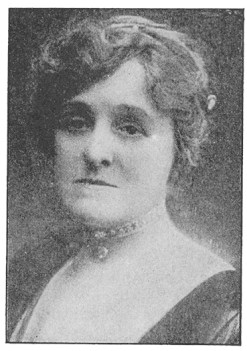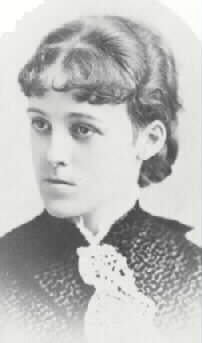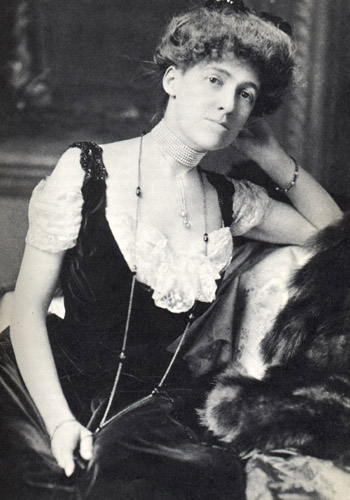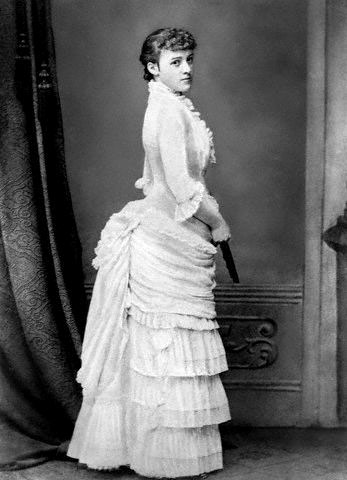<Back to Index>
- Mathematician Karl Georg Christian von Staudt, 1798
- Novelist Edith Wharton, 1862
- Roman Emperor Publius Aelius Hadrianus, 76
PAGE SPONSOR



Edith Wharton (January 24, 1862 – August 11, 1937) was a Pulitzer Prize-winning American novelist, short story writer and designer.
Wharton was born Edith Newbold Jones to parents George Frederic Jones and Lucretia Stevens Rhinelander. She had two brothers, Frederic Rhinelander and Henry Edward. The saying "Keeping up with the Joneses" is said to refer to the family of her father. This is not true, as the Joneses in the saying are characters from a comic strip. She shared a lifelong friendship with her Rhinelander niece, renowned landscape architect Beatrix Farrand, at 'Reef Point', in New York City and often together with Henry James in Europe. Wharton combined her insider's view of America's privileged classes with a brilliant, natural wit to write humorous, incisive novels and short stories of social and psychological insight. She was well-acquainted with many of her era's other literary and public figures, including Henry James and Theodore Roosevelt.
In 1885, at 23 years of age, she married Edward (Teddy) Robbins Wharton, who was 12 years her senior. From a well established Boston family, he was a sportsman and a gentleman of her social class and shared her love of travel, although they had little in common intellectually. He began spending money on younger women and this began to take a toll on Wharton's mental health. Escaping to Paris, in 1908 she began an affair with Morton Fullerton, a journalist for The Times and a friend of author and American anglophile Henry James. Wharton's personal diary, which would remain unknown to the general public until 1968, betrayed her romantic and intellectual involvement with Fullerton, both of which had been missing in her marriage. Wharton and her husband divorced in 1913, after she suffered a nervous breakdown and was confined to a hospital. She then moved to Europe permanently. While Edith and Edward Wharton were married for 28 years, she later called the marriage her "greatest mistake".
In addition to her famous novels, Wharton wrote at least 85 short stories. She was also a regarded garden designer, interior designer and lifestyle taste-maker of her time. She wrote several influential design books including her first published work, The Decoration of Houses of 1897, co-authored by Ogden Codman. Another is the beautifully and generously illustrated Italian Villas and Their Gardens of 1904, which has been reprinted to the present day. In 1902 she built The Mount, her estate in Lenox, Massachusetts, which survives today as an example of her design principles. The house and its gardens have
been extensively restored and are open to the public from May through
October. (In March 2008, the house museum was threatened with
foreclosure; however in May of 2009 The Mount announced a debt
restructuring agreement with its principal lenders. The agreement
reduced its funded indebtedness from $8.4 million down to $4.7 million.
The Mount is open to the public as of May 1, 2010, and its summer season
features a performance of Edith Wharton's Summer as well as the upcoming Berkshire Wordfest in July). There, Edith Wharton wrote several of her novels, including The House of Mirth (1905),
the first of many chronicles of the nature of old New York, and
entertained the cream of American literary society, including her close
friend, the novelist Henry James. Although
she spent many months traveling in Europe nearly every year, The Mount
was her primary residence until 1911. When she was there, as well as
traveling abroad, Wharton was usually driven to her appointments by her
longtime chauffeur and friend Charles Cook, a native of nearby South Lee, Massachusetts. When
her marriage deteriorated, however, she decided to move permanently to
France, living initially at 58 Rue de Varenne, Paris, in an apartment that belonged to George Washington Vanderbilt II. Helped by her influential connections to the French government, primarily Walter Berry (then
president of the American Chamber of Commerce in Paris), she was one of
the few foreigners in France who was allowed travel to the front lines.
Wharton described those trips in the series of articles Fighting France: From Dunkerque to Belfort. Throughout the war she worked tirelessly in charitable efforts for refugees and, in 1916 was named a Chevalier of the Legion of Honor in
recognition of her commitment to the displaced. The scope of her relief
work included setting up work rooms for unemployed French women,
organizing concerts to provide work for musicians, opening tuberculosis
hospitals and founding the American Hostels for Belgian refugees. In
1916 Wharton edited The Book of the Homeless, composed
of writings, art, erotica and musical scores by almost every major
contemporary European artist. When World War I ended in 1918 she
abandoned the fashionable urban address for the delights of the country
at the Pavillon Colombe in nearby Saint-Brice-sous-Forêt. Wharton
was a committed supporter of French imperialism, describing herself as
a "rabid imperialist", and the war solidified her political conservatism. After World War I, she travelled to Morocco as the guest of the resident general, Gen. Hubert Lyautey and wrote a book In Morocco,
about her experiences. Wharton's writing on her Moroccan travels is
full of praise for the French administration and for Lyautey and his
wife in particular. After the war she divided her time between Paris and Hyères, Provence, where she finished The Age of Innocence in 1920. In 1927 she purchased a villa, Castel Sainte-Claire, on the site of a 17th-century convent, in the hills above the city of Hyères in Provence, where she lived during the winters and springs. She called the villa
"Sainte-Claire du Chateau" and filled the garden with cacti and
subtropical plants. She returned to the U.S. only once after the war,
to receive an honorary doctorate degree from Yale University in 1923. The Age of Innocence (1920) won the 1921 Pulitzer Prize for literature, making her the first woman to win the award. She spoke fluent French as well as several other languages and many of her books were published in both French and English. Wharton was friend and confidante to many gifted intellectuals of her time: Henry James, Sinclair Lewis, Jean Cocteau and André Gide were all guests of hers at one time or another. Bernard Berenson and Kenneth Clark were valued friends as well; she was the godmother of Clark's second son, Colin (1932 – 2002), who wrote the book The Prince, the Showgirl and Me about his work as third assistant director of the film The Prince and the Showgirl. Her meeting with F. Scott Fitzgerald is
described by the editors of her letters as "one of the better-known
failed encounters in the American literary annals". She was also good
friends with Theodore Roosevelt. In 1934 Wharton's autobiography A Backward Glance was published. In the view of Judith E. Funston, in the entry she wrote for American National Biography about Wharton, "What is most notable about A Backward Glance,
however, is what it does not tell: her criticism of Lucretia Jones [her
mother], her difficulties with Teddy, and her affair with Morton Fullerton, which did not come to light until her papers, deposited in Yale’s Beinecke Rare Book Room and Manuscript Library, were opened in 1968." Edith Wharton died in 1937 at the domaine Le Pavillon Colombe, her 18th-century house on Rue de Montmorency in Saint-Brice-sous-Forêt, in the then existing département of Seine-et-Oise, but now in Val d'Oise. The street is today called Rue Edith Wharton. She is buried in the American Cemetery in Versailles, France. Wharton
continued writing until her death, lying in bed and dropping each
finished page to the floor to be collected when she finished. Wharton's
last novel, The Buccaneers, was unfinished at the time of her death. Marion Mainwaring finished
the story after studying the notes and synopsis Wharton had previously
written. The unfinished novel version was published in 1938, and
Mainwaring's completed version in 1993. Many of Wharton's novels are characterized by a subtle use of dramatic irony. Having grown up in upper-class pre-World War I society, Wharton became one of its most astute critics. In such works as The House of Mirth and The Age of Innocence she
employed both humor and profound empathy to describe the lives of New
York's upper-class and the vanishing of their world in the early years
of the 20th century. In contrast, she used a harsher tone in her novel Ethan Frome to convey the atmosphere of lower-class rural Massachusetts. In
addition to writing several respected novels, Wharton produced a wealth
of short stories and is particularly well regarded for her ghost
stories.

